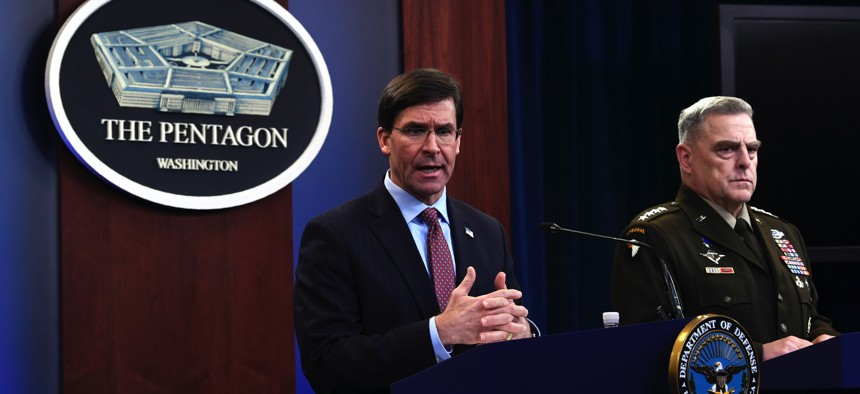
Defense Secretary Mark Esper, left, joined by Joint Chiefs​ Chairman Gen. Mark Milley, right, speaks during a news conference at the Pentagon in Washington, Friday, Dec. 20, 2019. AP / Susan Walsh
Now It's 64. Wounded Troop Tally from Iran Missile Strike Rises Again
Trump “understands the nature” of brain injuries, says Defense Secretary Esper after the president downplayed Americans’ wounds as not “serious.”
This story has been updated to reflect new information released by the Pentagon.
The number of U.S. troops who suffered traumatic brain injury, or TBI, in the Jan. 8 Iranian missile attack on an Iraqi military base rose to 64, according to a Defense Department spokesman.
The tally includes 14 new diagnosed cases of TBI since the Pentagon's last report on Tuesday, seven of which were treated in Iraq and returned to duty. In total, 21 troops have been sent to a military medical center in Germany for further treatment and eight to the United States. At least 11 more are awaiting transport to those locations for evaluation and treatment.
Gen. Mark Milley, chairman of the Joint Chiefs of Staff, at a Thursday press conference with Defense Secretary Mark Esper that the number of TBI cases was "growing," as time passed from blast and more service members showed signs of injury.
As of the evening, 39 troops of the 64 troops diagnosed with injuries had returned to duty.
"This is a snapshot in time and numbers can change. We will continue to provide updates as they become available," said Defense Department spokesman Lt. Col. Thomas Campbell, in the evening statement.
The severity of the injuries Americans sustained in the attack — and how seriously the Trump administration takes those injuries — has come under scrutiny after it was first revealed that 11 troops had been flown out of Iraq for treatment related to concussions and TBI symptoms, nearly one week after 11 missiles hit al-Assad air base. On Tuesday, officials said the number of affected troops had reached 50.
“We take this issue very seriously,” Esper said, in his opening statement. “We do everything we can to identify, treat, and help our service members recover and return to duty.”
President Trump and senior Pentagon leaders initially said no service members were killed or wounded in the attack. Last week, after several news reports from the base revealed that troops were being seen for concussions and other TBI symptoms, Trump downplayed the brain injuries, saying that he was told troops at the base had “headaches” and that he did not consider them to be as “serious” as physical wounds he had seen on other troops recovering at Walter Reed National Military Medical Center outside of Washington, D.C., from unrelated injuries.
Pressed by reporters, Esper said on Thursday that he has spoken with Trump and that the president "understands the nature of these injuries."
"He’s very concerned about the health and welfare of all of our service members, particularly those that were involved in our operations in Iraq,” Esper said.
Esper said he would not comment on whether he thought Trump was now better informed about these injuries, but said that “everybody” could use a refresher on TBI. The secretary said he is speaking to members of Congress and Pentagon is sending “teams of briefers” to Capitol Hill beginning Thursday to help members understand these kinds of wounds.
“This is an injury we need to keep educating everybody about,” he said.
Military leaders in the past two weeks have released several detailed updates on the number and status of those wounded. They also rejected theories that Trump or military officials concealed initial injury reports to tamp down any tensions with Iran, and assured the public that they take TBI injuries seriously — carefully evaluating and treating attack survivors as symptoms continue to emerge.
“The chairman and I spent most of the night [of Jan. 8] going over casualties and understanding what happened on the ground, with [U.S. Central Command’s] Gen. [Frank] McKenzie and others — I think the reporting was accurate at that time. At that time, as was reported, there were no casualties,” Esper said. “You learn these things over time.”
Related: Eleven US Troops Were Injured in Jan. 8 Iran Missile Strike
Related: 34 Injured in Iran Attack, Pentagon Now Says; Launches a Review of Reporting Procedures
Related: As Toll Mounts, Trump Downplays Injuries Suffered in Iranian Attack
Earlier this week, Pentagon officials said the number of troops reporting TBI symptoms had grown to 50. On Thursday, Milley and Esper said that they expected the symptoms of those troops already being tracked could worsen, and more troops with symptoms to emerge as time passes.
"It's too early to tell,” said Milley. “Mild traumatic brain injury, that's the diagnosis that's been reported to us so far."
Milley said the Defense Department for its own purposes rates traumatic brain injuries in one of three categories: very seriously injured, seriously injured, or not seriously injured. “These individuals are in the NSI category, at this time…. That’s not to minimize or dismiss or anything.”
He added: “There were thousands of people at al-Assad airbase. Those that were within the distance of the blast, these are thousand-, 2,000-pound munitions that were coming in, with heavy over-pressure, et cetera, — all those people are screened, and we got a certain number, and that number is growing.”
Milley said he did not want to reveal what new air or other defenses the Pentagon may be sending into Iraq, other than new Patriot anti-missile batteries requested by the regional combatant commander. Those are being held up by foreign red tape, and operational decisions of where they should be placed, he said.
“We need the permission of the Iraqis,” Esper said.
Milley added, “a Patriot battalion is not a small organization,” adding: “Could they have shot down these [Iranian ballistic missiles?] That’s what they were designed to do. Can’t say for certain.”




